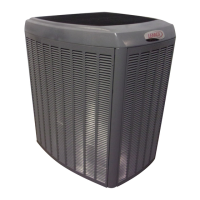Page 13
XC15 SERIES
3. Invert the cylinder of clean HCFC−22 and open its
valve to allow liquid refrigerant to flow into the system
through the suction line valve. Allow the refrigerant to
pass from the cylinder and through the line set and the
indoor unit coil before it enters the recovery machine.
4. After all of the liquid refrigerant has been recovered,
switch the recovery machine to suction recovery so
that all of the HCFC−22 suction is recovered. Allow the
recovery machine to pull a vacuum on the system.
5. Close the valve on the inverted HCFC−22 drum and
the gauge set valves. Pump the remaining refrigerant
out of the recovery machine and turn the machine off.
6. Use dry nitrogen to break the vacuum on the
refrigerant lines and indoor unit coil before removing
the recovery machine, gauges and refrigerant drum.
Installing New Indoor Unit Metering
Device
XC15 units are designed with HFC−410A TXV metering
devices. This section provides instructions on installing
TXV refrigerant metering device.
1
2
3
4
5
6
7
8
9
10
11
12
1/8 TURN
1
2
3
4
5
6
7
8
9
10
11
12
1/2 TURN
Figure 25. Tightening Distance
XC15 ENGINEERING HANDBOOK
See the XC15 Engineering Handbook for approved
indoor/outdoor match−ups, applicable TXV kits and
application information.
The following is the typical contents of a TXV kit:
TXV (1)
COPPER
MOUNTING
STRAP (1)
HEX HEAD BOLTS
AND NUTS (2)
TEFLON
RINGS (2)
Figure 26. TXV Kit Components
TYPICAL TXV INSTALLATION PROCEDURE
The TXV unit can be installed internal or external to the
indoor coil. In applications where an uncased coil is being
installed in a field−provided plenum, install the TXV in a
manner that will provide access for field servicing of the
TXV. Refer to Figure 27 for reference during installation of
TXV unit.
To prevent any possibility of water damage, properly
insulate all parts of the TXV assembly that may sweat due
to temperature differences between the valve and its
surrounding ambient temperatures.
1. Remove the field−provided fitting that temporary
reconnected the liquid line to the indoor unit’s
distributor assembly.
2. Install one of the provided Teflon rings around the
stubbed end of the TXV and lightly lubricate the
connector threads and expose surface of the Teflon
ring with refrigerant oil.
3. Attach the stubbed end of the TXV to the liquid line
orifice housing. Finger tighten and use an appropriately
sized wrench to turn an additional 1/2 turn clockwise
as illustrated in figure 25, or 20 ft−lb.
4. Place the remaining Teflon ring around the other end
of the TXV. Lightly lubricate connector threads and
expose surface of the Teflon ring with refrigerant oil.
TWO PIECE
PATCH PLATE
(UNCASED COIL
ONLY)
SUCTION
LINE
LIQUID LINE
ORIFICE
HOUSING
DISTRIBUTOR
TUBES
LIQUID
LINE
MALE EQUALIZER LINE
FITTING (SEE FIGURE 29
FOR FURTHER DETAILS)
SENSING
LINE
EQUALIZER
LINE
TXV
TEFLON
RING
(Uncased Coil Shown)
SENSING BULB INSULATION IS
REQUIRED IF MOUNTED EXTERNAL
TO THE COIL CASING. SEE FIGURE 28
FOR BULB POSITIONING.
STUB END
TEFLON
RING
LIQUID LINE ASSEMBLY
WITH BRASS NUT
DISTRIBUTOR
ASSEMBLY
Figure 27. Typical TXV Installation
5. Attach the liquid line assembly to the TXV. Finger
tighten and use an appropriately sized wrench to turn
an additional 1/2 turn clockwise as illustrated in figure
25, or 20 ft−lb.

